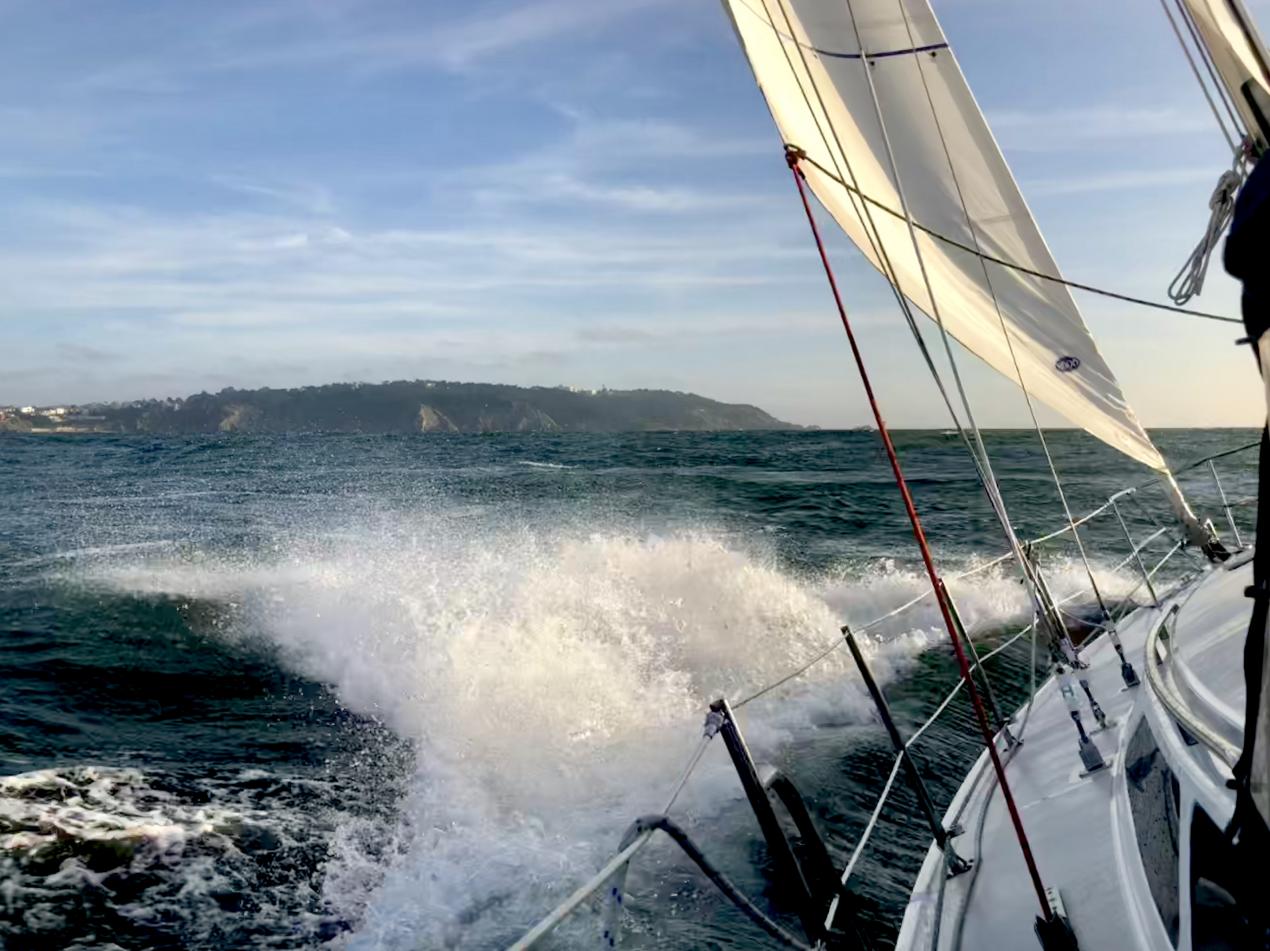
The allure and promise of summer on San Francisco Bay: intense wind, swift currents, eerie fog, ever-changing conditions and busy traffic will engage and challenge you, sharpen your skills, and build your confidence as a sailor. And there’s something undeniably exhilarating and empowering about sailing well in high wind. That feeling can be very addictive, which is why those avid SF Bay sailors who aren't intimidated by 25 knots of wind might look a little nutty to the uninitiated. On the contrary - practical knowledge, preparation, and practice are key in enabling safe, enjoyable, and rewarding summer sailing.
Here are 9 keys to help you make the most of San Francisco Bay's summer sailing conditions.
1. Understand the Bay's summer wind patterns.
Sea breezes occur due to differences in air temperatures above the ocean and land, and the greater the difference, the stronger the breeze. Summer winds tend to be lightest in the morning, usually less than 10 knots. As the climbing sun bakes the Central Valley, rising warm air forms a low-pressure area above land that draws in the much cooler, high-pressure air situated over the Pacific Ocean. As this cool air flows through the Golden Gate Strait and Central Bay (the area known as “the Slot,”) it condenses and accelerates, developing into the refreshing, steady and strong winds that the Bay is famous for. These spring and summer winds generally range in speed from 15 to 30 knots and can feel downright chilly.
Most of the Bay's waters are sheltered from Pacific Ocean swell, allowing you to test your skills in big wind without also having to tackle massive waves. But a strong west or southwest wind blowing against an ebb tide can make for an exhilarating, splashy sail, especially when sailing to weather. Plan your passes under the Golden Gate Bridge during a slack or flood tide - it can get rough during the ebb.
Need a break from the wind? Sail behind landmasses such as the eastern side of Angel Island and the Tiburon Peninsula and take a breather in suddenly gentler winds and warmer sunshine for a while. You may need to shake out a reef, start the engine, and/or shed a layer of clothing… at least until you find yourself in the path of the wind again.
In the evening as the Central Valley cools, winds on the Bay begin to settle into a pleasant conclusion to the day’s sailing. Docking, anchoring, or mooring will be easiest just before sunset when wind conditions tend to be light and there is still some daylight to see by.
2. Trim and reef smartly.
On San Francisco Bay, wind velocity can vary widely depending on location and time of day. Reefing is an essential skill that will be called upon frequently.
- Always check the wind and tides forecast before heading out.
- Take some time to familiarize yourself with your boat’s reefing system before you leave the dock.
- Consider whether to preset a reef or two in the mainsail before leaving the dock. Two rules to make standard practice: 1) It’s better to have too little sail up than too much. 2) It’s easier to shake out a reef than it is to put one in.
- 15 – 20 knots predicted: preset 1 reef in the mainsail before leaving the dock. (Smaller/lighter boats like our J/24's may need a first reef sooner at around 12 knots of wind.)
- 20 knots or more predicted: preset 2 reefs at the dock.
- In high wind, you can depower a sail to some degree by flattening its shape.
- Flatten the mainsail by tightening the outhaul and/or boom vang and adjust the traveller to leeward.
- Flatten the jib by moving the jib cars aft.
- It’s past time to reduce sail area and reef down when:
- you’re thinking about reefing, or
- your crew looks uncomfortable.
- If the wind blows 30 knots or more sustained, douse/furl the sails and head back to base (per MSC charter policy).
3. Keep an eye on traffic.
On any given summer day, the Bay will be plentifully peppered with other sailboats, regattas, recreational fishing vessels, and even sailboarders and parasailers. Crew must keep a sharp lookout for recreational vessels and the usual ferries and ships, and take care to follow Coast Guard navigation rules.
Rule 5 - Lookout
Every vessel shall at all times maintain a proper look-out by sight and hearing as well as by all available means appropriate in the prevailing circumstances and conditions so as to make a full appraisal of the situation and of the risk of collision.
Learn more about SF Bay traffic patterns.
4. Coping with "Karl."
When cool ocean air arrives in the Bay Area, the moisture it brings with it often condenses into thick fog. Dubbed "Karl" by locals, this fog frequently blankets San Francisco and the Bay from May through August. This type of fog is known as advection fog sweeping in over cool water – so dense that it can persist despite strong winds. You’re better off dodging Karl, but should you be caught in the thick of low visibility:
- Switch on the running lights.
- Ring your ship’s bell or briefly blast the air horn once every two minutes to make your presence audible to nearby mariners. (One prolonged blast for motoring, one prolonged blast followed by two short blasts if sailing.)
- Use your sense of hearing to increase your awareness of your surroundings. Turn off the music and minimize conversation. While navigating, listen for audible clues such as bell, gong, or whistle buoys, the fog horns on the bridge’s north and south towers, and for approaching ships.
- Navigation and AIS apps on your smartphone can be helpful, but don’t be so distracted by them that you neglect to pay attention to your surroundings.
- To be well-prepared for possible low-visibility conditions, be sure to check out our article How To Find Your Way Back to MSC Base in the Dark or Fog.
5. Plan low-stress, low-mess snacks and meals.
- Bite-sized finger foods and sandwiches are much easier to manage in high-wind conditions than meals that require the use of utensils. It’s ideal to keep one hand free – one hand for your food, the other for the boat.
- Bowls are always better than plates when the boat is moving.
- Keep glass containers out of the cockpit and well-secured in the galley when the wind and chop are up.
- Stainless steel or other shatter-proof material food containers and water bottles are ideal for sailing.
- Mealtimes are always a perfect excuse to practice heaving-to and anchoring.
6. Avoid imparting Neptune with unintended gifts.
- Hats: Wear a hat with a chin strap or clip it to your collar with a hat leash.
- Glasses/Sunglasses: Use a leash, keepers or croakies to keep your specs attached to you.
- Mobile phone: If you like to use nautical apps or take lots of photos, keep your smart phone in a waterproof pouch with lanyard.
- Lightweight plastic bags and containers are easily blown overboard by summer’s strong winds. Keep them in the salon or avoid bringing them aboard altogether.
7. Take care of yourself.
- Dress in layers. A windbreaking and waterproof outer layer (such as foul weather gear) is a must for a Bay sailor’s comfort in all seasons - even in the summertime.
- Motion-sensitive sailors will benefit by beginning mal-de-mer prevention measures the night before a planned sailing excursion.
- Generously apply sunscreen to protect your skin from the intense summer sun.
- Gloves become even more handy when strong winds heighten the risk of line chafe injuries. Skippers: carry an extra pair in case a crew member forgets to bring theirs.
- Footwear with grippy non-marking soles is essential.
- Drink plenty of water. The wind can be very dehydrating.
- For more self-care and safety tips, read Common Sailing Injuries and How to Prevent Them.
8. Take care of the boat.
- Be sure to close and seal all hatches before heading out of the marina.
- Reef on the side of caution. Don’t be tempted to push the boat too hard.
- Limit the luffing and flogging of sails and sheets as much as possible. Our article Four Essential Sail Care Tips for MSC Charterers explains how.
- Avoid jibing in high winds if your crew is inexperienced. Heaving-to, a.k.a. “chicken jibe” (or chicken gybe), or as Capt. Jeff Cathers calls it: "Super Tack" is a safe alternative maneuver, well-suited to calmer, downwind sail control.
- When furling the jib, go to a broad reach to blanket the jib with the mainsail. This will take pressure off the sail to make it easier to furl and also reduces flogging. Wrap the sheets 2-3 times around the furled sail, and ensure that the jib sheets are cleated off in the winch’s self-tailing jaws. This prevents the jib from unfurling at the dock.
- Before leaving the boat, ensure that there is no slack in the spring lines and that the fenders are well-positioned between the boat’s freeboard and the dock. Learn more about this in our article How to Tie Dock Lines and Fenders.
9. Keep it fresh.
No matter how striking and iconic the scenery, sailing in circles around the same territory can get stale after awhile. When you continually challenge yourself by adding variety to your sailing excursions, you'll banish boredom while expanding the breadth and depth of your sailing experience and skills. Check out our Local Cruising Guides for some ideas. Also, practicing your docking and anchoring skills in a variety of local destinations is excellent preparation for international chartering or world cruising.
Modern Sailing members receive discounts when chartering for 2 or more consecutive days. When you charter for 2 days, you'll receive a 10% discount off the overall charter rate for both days. When you charter for 3 or more consecutive days, your discount is 15%!
Article by Mary Elkins on July 9, 2020, updated July 10, 2025 with the guidance of Modern Sailing Head of School, Capt. Jeff Cathers


